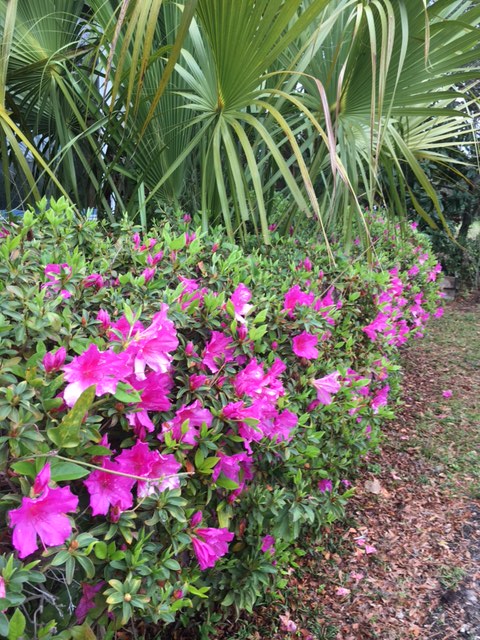
by Rick O'Connor | Feb 18, 2017
It was February 13, 2017 and the temperature was 74°F… 74! It has been one strange winter. The azaleas in my yard have already bloomed, friends of mine have seen butterflies already forming chrysalis, and I have already had to deal with mosquitos; all of this in February. But, even as we talk about how warm this winter has been in the panhandle, they are having record snowfall in the Midwest and Northeast. It has been a strange winter.
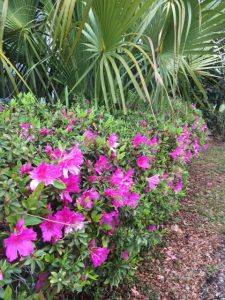
Azaleas typically bloom near Easter. These bloomed in mid-February in 2017.
Photo: Rick O’Connor
It is easy to change this discussion to climate change, but we have had weird winters before. There was the winter when George Washington crossed the Delaware, apparently colder than normal for that part of the country that year. I remember as a kid having to wear a heavy coat to school in the winter and frost was on the ground most mornings – I grew up in the panhandle by the way.
In the book Sea Level Rise in Florida; Science, Impacts, and Options, Dr. Albert Hine (University of South Florida) explains why these periodic cold and warm years occur. Our orbit around the sun is not a perfect circle; the elliptical path can adjust our distance and change the amount of solar radiation we receive from Mother Sun. Then there is the wobble effect. The rotation of the Earth on its axis is similar to a spinning top, and the wobble can alter the amount of solar radiation we receive. These orbits and rotations explain the ice age and warm periods have experienced, and Dr. HIne provides geologic evidence that supports these climate change periods. The weird thing is, based on our current orbit/rotation pattern we should be in a cooling period and heading towards an ice age. But we are not, actually the last three years have been the warmest on record. So, if the stars say we should be heading towards a cooling period, and it is warming, the question begs – why?
Well, Dr. Hine suggest that it must be our activities. Man has made so many changes that have affected our planet in so many ways that some are saying we are in a period of the Earth’s history they are calling “Anthropocene”. It is hard to argue with it. Look out your window next time you are flying and see how we have changed the landscape. You cannot see these changes as you fly over the ocean, but the changes are there. Warm surface water usually overrides cooler waters at depth. The circulation of warm and cold water due to differences in density cause the currents, which cause the wind patterns, which effects our climate. The ocean is a great absorber of heat, and it is doing just that – absorbing heat, which is now reaching deeper depths. This will certainly effect the currents and the climate. Most will point at the use of fossil fuels as the change that has had the biggest impact on all of this.
So, if this is the case, what do we do about it?
Well there are models predicting what the future climate and sea levels might be, based on potential use of resources. There is nothing, at the moment, that suggest we are going to do anything different in how we use these resources so we can expect these climate changes to continue. Will 2017 follow the current trend and become the warmest year on record yet? Will flowering plants alter their cycles based on temperatures? Are rainfall patterns going to change? Will tropical species, including invasive ones, be able to colonize north Florida? I am not sure, but I think we should consider these possibilities as we plan for our future use of the landscape. Until then, we should enjoy the nice February we are having, and hope July and August are not too bad. We will see what next year brings.
If you are interested in reading more about the science of Florida’s climate, I recommend reading
Seal Level Rise in Florida; Science, Impacts, and Options. Hines, Chambers, Clayton, Hafen, and Mitchum. 2016. University Press of Florida. ISBN 9780813062891.
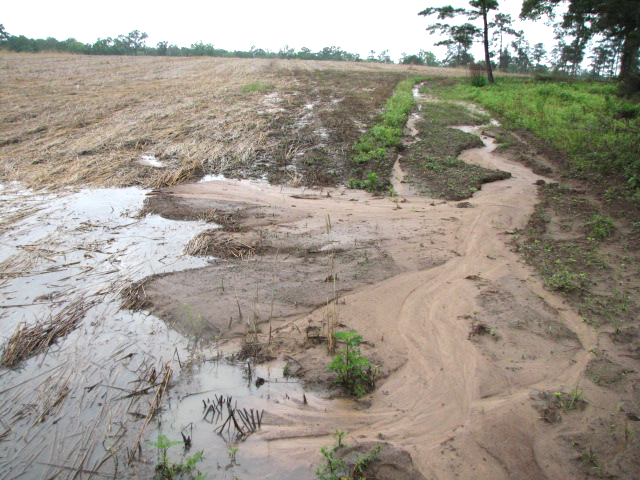
by | Feb 18, 2017
 One of the great barriers to progress in most policy discussions is an “Us” vs. “Them” battle based on historic generalizations and unawareness of change and current practices of the two “sides”. The bad news is there has been much such conflict between “farmers” and “environmentalists”, but there is good news out there. As contentious as discussions of conservation and climate change have been, agricultural practices are being driven by changing weather patterns and budget busting input and commodity prices. The beneficiary is soil and water quality and an increase in carbon sequestration.
One of the great barriers to progress in most policy discussions is an “Us” vs. “Them” battle based on historic generalizations and unawareness of change and current practices of the two “sides”. The bad news is there has been much such conflict between “farmers” and “environmentalists”, but there is good news out there. As contentious as discussions of conservation and climate change have been, agricultural practices are being driven by changing weather patterns and budget busting input and commodity prices. The beneficiary is soil and water quality and an increase in carbon sequestration.
As a recent article in the New York Times discusses, much of this change is pragmatic, not philosophical or political. With “Almost 1.7 billion tons of topsoil are blown or washed off croplands a year, according to the Department of Agriculture”, American farmers’ innovative practices are addressing a vast problem which creates “billions of dollars in losses for farmers” and untold damage to water quality.
In recent years, row crop farmers across North Florida are increasingly adopting no till planting and returning to cover crop plantings to reduce erosion, increase water infiltration, smother out weeds and keep soils cooler during our blistering summers. Here’s the story of the Florida Soil Health and Cover Crop Group’s first meeting in 2015 and its impact in one field in Jefferson county.
It wasn’t raining on April 1st, when the inaugural tour was held. Participants heard descriptions of the value of a winter cover crop,such as cereal rye, in the production of a warm season cash crop. “Discover the Cover” was hosted by Jefferson County UF/IFAS Extension, the Jefferson County Soil and Water Conservation Board, and the Jefferson County office of the USDA Natural Resources Conservation Service in cooperation with the Florida Department of Agriculture and Consumer Services Office of Agricultural Water Policy, Brock Farms. Fulford Family Farms and Fulford 6 Farm.
Kirk Brock told of his years of experience of knocking down a cereal rye cover crop and leaving it on the field to reduce erosion, increase soil organic matter, shade out weeds and increase soil water infiltration. “We fertilize the cover crop and use that rye biomass to provide fertility for the summer crop,” Brock said. His soil pits showed attendees how rye roots penetrate the soil profile and leave channels for movement of water and crop roots to follow. “We got tired of moving our topsoil back up the hill every year,” Brock said when he explained his journey from conventional farming to no-till planting on his hilly, dry land acreage. “If I had to go back to conventional planting, I’d get out of farming,” the Jefferson County native has said.
After leaving Brock Farms, the group moved to a rye termination demonstration by members of the Fulford families. Visitors watched two different machines flatten the rye in preparation for planting. “It’ll help slow down water movement and keep the soil in the field, “grower Stephen Fulford said as the shiny new roller got its first chance to flatten Florida rye. The roller lays the mature rye down and a herbicide application insures it doesn’t get back up. Stalks aren’t severed; they remain attached to the plant’s mature roots, providing an anchored set of numerous, small obstacles to prevent water flow and soil erosion.
On a warm blue sky day, it was a little hard to visualize the effect the rolled rye might have on surface erosion. As usual, things change. I returned to the roller demonstration field on May 1 after lunch. It had just stopped raining, and the fire ant hills didn’t even have dry dirt on top of them yet. One of the wettest Aprils in history, (11.9” at the Monticello Florida Automated Weather Network station) had concluded with 3.1” of rain on the 29th and 30th. An additional 0.98” (4.08” in less than sixty hours) had fallen that morning.
Water was running down the field road, through a recently harrowed fire line and into the field. The amazing thing? The sediment went no further than three feet into the rye. The rye mat had stopped the sediment and clear water was moving slowly across the field underneath the rolled rye. The still attached rye stems remained parallel to each other.
One of the questions asked at “Discover the Cover” concerned cost effectiveness of such a system. More research needs to be done on actual costs, but one financial fact is as clear as the water at the bottom of these fields. These farmers will be planting as soon as their fields dry out. They won’t be burning any diesel to haul their topsoil back up the hill, and that good Jefferson County soil won’t be lost to the Gulf of Mexico. That’s good news for everybody.
More complete information is available on the high biomass cover crop system in the following UF/IFAS publication: Agricultural Management Options for Climate Variability and Change: High-Residue Cover Crops. If you’d like additional information on cover crop and soil health practices, contact Dr. David Wright at wright@ufl.edu or Dr. Danielle Treadwell at ddtreadw@ufl.edu.
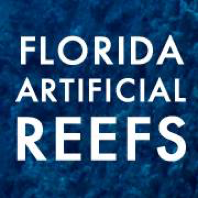
by Scott Jackson | Feb 16, 2017
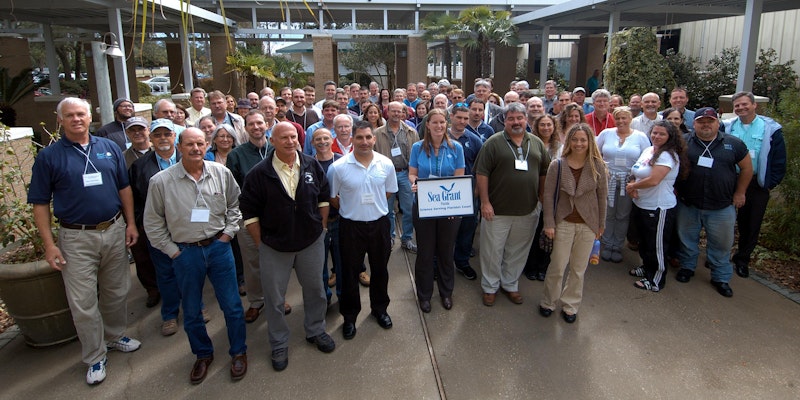
Northwest Florida Workshop Attendees from 2013 in Niceville, FL. This year’s workshop will be held at the UF/IFAS Extension Okaloosa County Office in Crestview, February 22, 2017. Direction and Contact Information can be found at this link http://directory.ifas.ufl.edu/Dir/searchdir?pageID=2&uid=A56
Researchers from University of West Florida recently estimated the value of Artificial Reefs to Florida’s coastal economy. Bay County artificial reefs provide 49.02 million dollars annually in personal income to local residents. Bay County ranks 8th in the state of Florida with 1,936 fishing and diving jobs. This important economic study gives updated guidance and insight for industry and government leaders. This same level of detailed insight is available for other Northwest Florida counties and counties throughout the state.
The UWF research team is one of several contributors scheduled to present at the Northwest Florida Artificial Reef Manager’s Workshop February 22. Florida Fish and Wildlife Commission and Florida Sea Grant are hosting the workshop. This meeting will bring together about fifty artificial reef managers, scientists, fishing and diving charter businesses, and others interested in artificial reefs to discuss new research, statewide initiatives and regional updates for Florida’s Northwest region. The meeting will be held at the UF/IFAS Extension Okaloosa County Office in Crestview, FL.
Cost is $15.00 and includes conference handouts, light continental breakfast with coffee, lunch, and afternoon refreshments. Register now by visiting Eventbrite or short link url https://goo.gl/VOLYkJ.
A limited number of exhibit tables/spaces will be available. For more information, please contact Laura Tiu, lgtiu@ufl.edu or 850-612-6197.
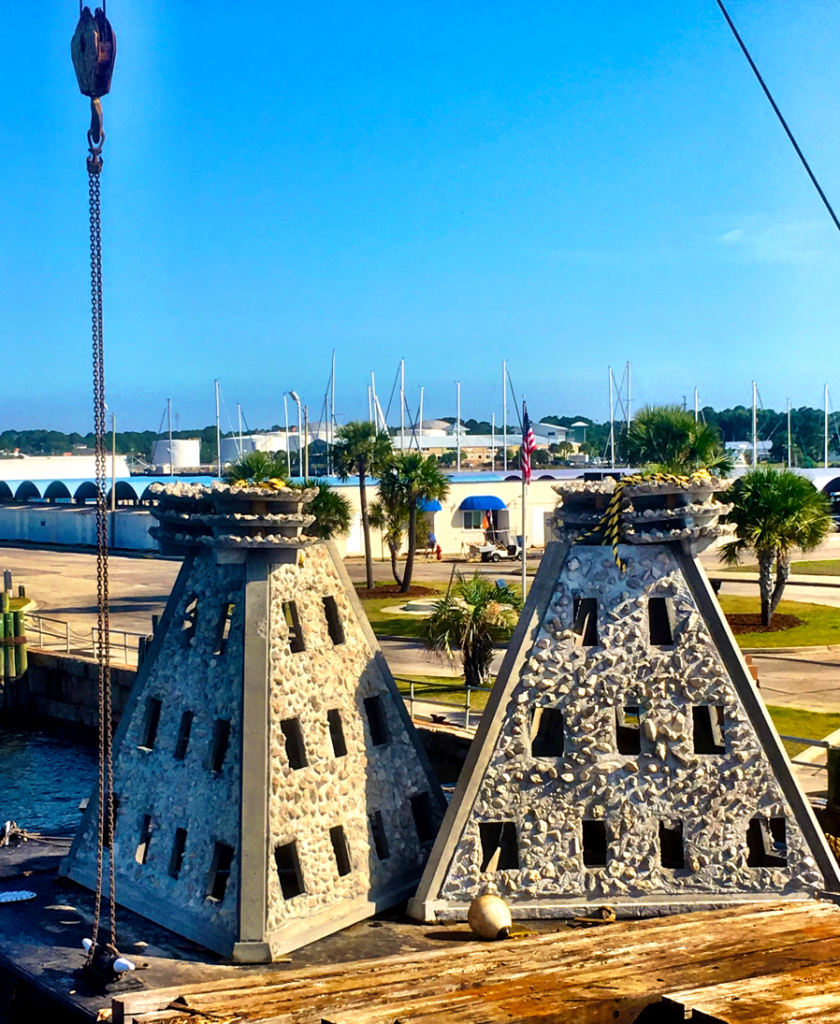
Super Reefs staged at the Panama City Marina, which were deployed in SAARS D, located 3 nautical miles south of Pier Park. Learn more about this reef project and others at the Northwest Florida Artificial Reef Manager’s Workshop in Crestview, February 22, 2017. (Photo by Scott Jackson).
Northwest Florida Artificial Reef Workshop Tentative Agenda
Date: February 22, 2017
Where: UF/IFAS Extension Okaloosa County Office, 3098 Airport Road Crestview, FL 32539
8:15 Meet and Greet
9:00 Welcome and Introductions – Laura Tiu UF/IFAS Okaloosa Co and Keith Mille, FWC
9:25 Regional and National Artificial Reef Updates – Keith Mille
9:50 Invasive Lionfish Trends, Impacts, and Potential Mitigation on Panhandle Artificial Reefs – Kristen Dahl, University of Florida
10:20 Valuing Artificial Reefs in Northwest Florida – Bill Huth, University of West Florida
11:00 County Updates – Representatives will provide a brief overview of recent activities 12:00 LUNCH (included with registration)
12:00 LUNCH
1:00 NRDA NW Florida Artificial Reef Creation and Restoration Project Update – Alex Fogg, FWC
1:15 Goliath Grouper Preferences for Artificial Reefs: An Opportunity for Citizen Science – Angela Collins, FL, Sea Grant
1:45 Current Research and Perspectives on Artificial Reefs and Fisheries – Will Patterson, University of Florida
3:00 BREAK
3:30 Association between Habitat Quantity and Quality and Exploited Reef Fishes: Implications for Retrospective Analyses and Future Survey Improvements – Sean Keenan, FWRI
3:50 Innovations in Artificial Reef Design and Use – Robert Turpin, facilitator
4:10 Using Websites and Social Media to Promote Artificial Reef Program Engagement – Bob Cox, Mexico Beach Artificial Reef Association & Scott Jackson, UF/IFAS Bay Co
4:40 Wrap Up and Next Steps – Keith Mille and Scott Jackson
5:00 Adjourn and Networking
Register now by visiting Eventbrite or short link url https://goo.gl/VOLYkJ. Live Broadcast, workshop videos, and other information will be available on Facebook at https://www.facebook.com/floridaartificialreefs/ (Florida Artificial Reefs) .

An Equal Opportunity Institution. University of Florida, Institute of Food and Agricultural Sciences (UF/IFAS) Extension, Nick T. Place, Dean.
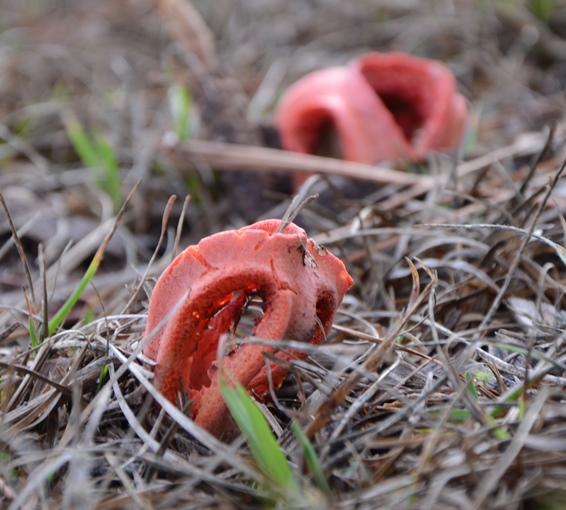
by Les Harrison | Feb 4, 2017
Valentine’s Day is just a few days away and this month’s theme is evidenced by the color red. Red hearts, bows, roses (imported this time of year from South America) and candy in red boxes
This hue is not frequently seen in Wakulla County in the mist of winter’s grip, but this year azaleas bloomed in January. Still, red highlights in lawns, pastures and other open areas tend to attract attention.
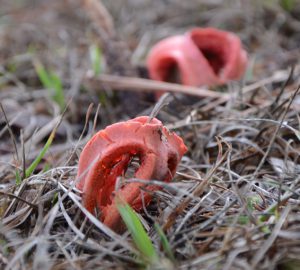
Mature Column Stinkhorns are in striking contrast to most other local mushrooms. These were growing on the edge of the UF/IFAS Wakulla County Extension Demonstration Garden where wood chips are plentiful.
Photo: Les Harrison
The reason is simple. A mushroom species is taking advantage of the cool weather and available moisture.
Clathrus columnatus, the scientific name for the column stinkhorn, is a north Florida native which is common to many Gulf Coast locales. This colorful fungus has also been known by the common name “dead man’s fingers”.
The short lived above ground structure is usually two to six inches high at maturity. This area is known as the fruiting body and produces spores which are the basis for the next generation.
Two to five hollow columns or fingers project upwards above the soil or mulch. Coloration of the fruiting body can range from pink to red, and occasionally orange.
The inner surfaces of the column are covered with stinkhorn slime and spores, and which produces an especially repulsive stench. This foul odor is useful though, attracting an assortment of flies and other insects which track through it.
A small amount of the mixture of the brown slime and spores attaches to the insect’s body. It is then carried by these discerning visitors to other bug enticing spots, usually of equal or greater offensiveness to people. Spores are deposited as the slime mixture is rubbed off as the insects brush against surfaces.
Decaying woody debris is a favorable environment for the column stinkhorn to germinate. As the wood rots bacterial activity makes necessary nutrients available to this mushroom.
Other areas satisfactory for development include lawns, gardens, flower beds and disturbed soils. All contain bits and pieces of decomposing wood and bark.
Occasionally, column stinkhorns can be seen growing directly out of stumps and living trees. Presence on a living tree is a good indication the tree has serious health issues and may soon die.
This fungi starts out as a partially covered growth called a volva. The portion above and below the soils surface has the general appearance of a hen’s egg and is bright white.
The term volva is applied in the technical study of mushrooms, and used to describe a cup-like structure at the base of the fungus. It is one of the precise visible features used to identify specific species.
The cool wet weather currently in Wakulla County combined with local sandy soils and available nutrients create ideal growing conditions. While rarely notices during initial stages of growth, they are quickly spotted at or near maturity.
There are other stinkhorn mushrooms in Wakulla County, but they are not as common. In addition to North America, member of this fungi family with a fetid aroma can be found in Europe, Asia, South America and Australia.
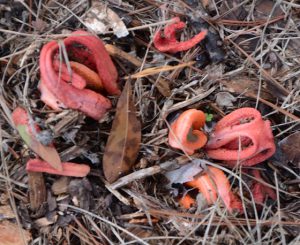
Photo: Les Harrison
While not likely to be a Valentine’s Day gift, it still has a distinct place in the local environment. Get close and it is difficult to overlook.
To learn more about Wakulla County’s mushrooms, contact your UF/IFAS Wakulla Extension Office at 850-926-3931 or http://wakulla.ifas.ufl.edu/
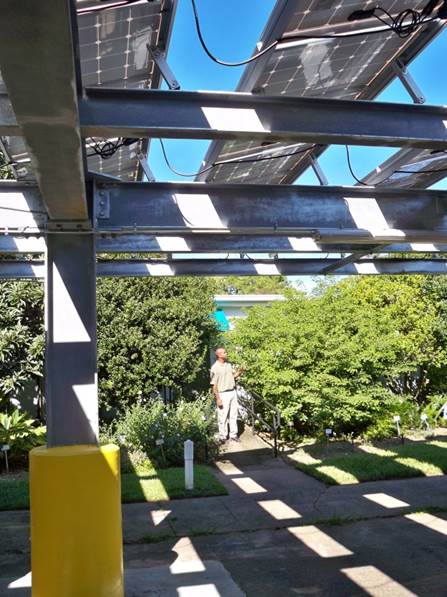
by Will Sheftall | Feb 4, 2017
I know you’ve seen the rear window decals that announce in stick figures just who could be riding in that SUV – mom, dad, kids of various sizes, and sometimes pets. A clever Florida variation uses big and little flip-flops and paw prints to paint the same picture.
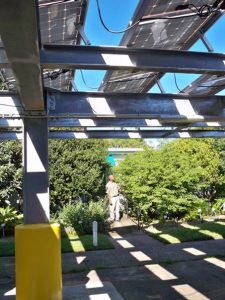
Shade pattern under Leon Extension Solar PV array
Photo: Will Sheftall
Flip-flops on the beach = footprints in the sand = carbon footprints on the Earth – at least, that’s how my mind processes this voluntary family accounting, posted for all to see. I wonder if I’m the only driver out there who studies a family’s flip-flop line-up at the stop light, and ponders our human family’s footprint on Earth’s climate and other natural resources.
My mind can imagine the line-up of flop-flops as belonging just to me. The two big pairs (representing mom and dad on the rear glass) evoke the four big lifestyle footprints I leave on this Earth. My lifestyle footprints are made by what I eat and how it was produced, the way I commute and travel, the buildings in which I live and work, and by what I wear and how it was made. Lifestyle footprints left on Earth’s resources are the water and energy I consume directly and indirectly, plus greenhouse gas emissions and wastes with my name on them.
Wouldn’t it be great if we could shrink the size and impact of one of those pairs of big flip-flops with an integrated solution, a twofer – reducing two of our lifestyle footprints by linking them together? There is an opportunity to do just that by combining solar PV (solar photovoltaics, better known as solar panels) with EVs (electric vehicles), to achieve an integrated reduction in the energy and carbon footprints of the two together. This opportunity is available to families for home application, and to agencies/ businesses for work application. It’s particularly exciting to envision the prospect of reducing commercial/ institutional CO2 footprints by combining net-metered solar PV on zero-net office buildings and warehouses, with EV’s for business errands and local deliveries.
Here’s some insight into how this might work. The office building in which I work is an award-winning, energy-exporting “Sustainable Demonstration Center” for Leon County government. It’s the UF IFAS Extension Center in Leon County, on Paul Russell Road. Constructed in 1961 and retrofitted with solar PV and geothermal HVAC in 2012, it was certified in 2014 by the New Buildings Institute as the third commercial/ institutional “zero-net energy” building in Florida. It has a grid-tied, net-metered system.
In the 4¾ years since our facility’s solar PV and geothermal energy systems went on-line in March 2012, thermostats in this County government building have been managed to obtain even greater energy conservation than was envisioned when planning the retrofit. As a result, our facility has exported a continually growing net surplus of energy to the City of Tallahassee Utilities grid – over and above covering its own energy needs. The amount of surplus energy donated since just August 2014 stands at 24,400 kWh.
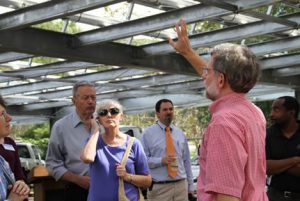
Visitors learn about the solar PV system from Extension Agent Will Sheftall.
Photo: Kendra Zamojski
To put this amount of energy into context, let’s consider what mechanical work 24,400 kWh of electrical energy can do. Here’s where the other half of the twofer opportunity comes in. On an accessible battery charge of 10.5 kWh, an extended range electric vehicle (EV) such as the Chevrolet Volt goes a summer/ winter average of 40 miles on stored battery power alone. 24,400 kWh would provide the equivalent of 2324 EV charges at 10.5 kWh per charge. That’s enough stored battery power for 92,960 electric miles!
Forget about this surplus from the past for a moment. Let’s compute the repeating annual surplus of clean solar energy produced by our PV array, and apply that to the opportunity for integrating building and travel footprints at Leon Extension. If we compute that our solar PV system has produced – over the past 2.3 years – an annual energy surplus equivalent to 997 EV charges per year, and if we project that Extension Agents could utilize County vehicles to travel 40 miles every work day for 245 work days/year, then we find there would be enough surplus energy produced every year to fully charge a fleet of four EVs at 10.5 kWh per charge/day, for use on the job every single work day.
This is exciting stuff! With more auto manufacturers offering new EV models with longer ranges and lower prices – and with extension through 2019 of the 30% federal tax credit for residential solar and the 30% federal Business Energy Investment Tax Credit (ITC) for business solar, the future of PV + EV looks bright. Perhaps this rosy outlook will encourage government offices and businesses around town to shrink those two big flip-flops down in size with a twofer, and ‘Leave a Lower Carbon Footprint Trace’ on the Earth.












